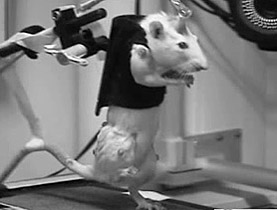
New treatment gets rats back on their feet

Researchers at Zurich University have developed a new therapy combining drugs, electrical stimuli and treadmill workouts that helps paralysed rats walk again.
The treatment, which targets the neural circuits in the spinal cord that control the muscles used for walking, could lead to clinical trials in humans in five years time, scientists hope.
The spinal cord is the pathway through which signals from the brain reach the muscles. If it is damaged, transmission is interrupted, preventing muscle movement.
Neural circuits that exist in the spinal cord can trigger movement without the brain intervening if the correct electrical stimuli or drugs are administered. Past experiments have shown this to be the case, although the animals involved were unable to support their own weight.
Grégoire Courtine and his colleagues in Zurich and at the University of California at Los Angeles took this one step further by combining the two therapies with treadmill exercise.
They severed the spinal cords of several rats and injected them with drugs including one that mimics serotonin, which is found in the central nervous system. Serotonin helps control muscle movement.
Electricity, then rehabilitation
The spinal cords were then stimulated electrically using electrodes placed on the animals’ skin.
This treatment reactivated the rats’ paralysed lower limbs. The animals were then put through a two-month rehabilitation process.
“They were able to walk very quickly and after two months were able to walk for half an hour [on the treadmill] bearing their own weight,” Courtine told swissinfo.ch. “They were also able to adapt their walk pattern to different conditions.”
This adaptation shows that the neural circuit is “smart”, learning to react when disconnected from the brain.
The treatment has no permanent effects, according to Courtine, whose results were published in the latest issue of the Nature Neuroscience journal. “What we have shown is that the rats can walk or run without a connection to the brain, although it requires outside intervention to make it happen,” he added.
The researchers have suggested that the drugs prepare the neural circuit for activation by the electrical stimuli, with rehabilitation completing the process.
Courtine and his team would like to apply their research to people with severe spinal cord injuries in the future, even if there is no hard proof yet the rat study can be applied to humans.
Regain some movement
“The idea is to develop a neuroprosthesis for the spinal cord, basically a set of electrodes that can be implanted below a lesion, to stimulate and activate the circuits,” said Courtine.
“We might be able to help people with severe lesions, with some circuits intact – not enough normally for them to walk – regain some movement.”
Electrical stimulation would pass through a set of tiny electrodes implanted next to the spinal cord. Similar technology already exists for pain management , the real challenge being the number of electrodes required and the complexity of the setup says Courtine.
“Later it might be possible to consider a type of brain-machine interface,” he added, “where the brain neurons partially control the stimulation.”
The research could also have further implications for some neurodegenerative diseases, according to Courtine.
“It might be possible to reduce symptoms in Parkinson’s and multiple sclerosis patients,” he said. “Prostheses for lesions or damage to the connections between the brain and the spinal cord could help overcome various problems.”
swissinfo.ch and agencies
Serotonin is a neurotransmitter. It acts both as a chemical messenger that transmits nerve signals between nerve cells and causes blood vessels to narrow.
Serotonin is found extensively in the gastrointestinal tract of animals, and about 80 to 90 per cent of the human body’s total serotonin is located in the gut, where it is used to regulate intestinal movements.
The remainder is synthesized in serotonergic neurons in the central nervous system where it has various functions, including the regulation of mood, For example, medications that affect the action of serotonin are used to treat depression.
Serotonin levels also affect appetite, sleep, muscle contraction, and some cognitive functions including memory and learning.

In compliance with the JTI standards
More: SWI swissinfo.ch certified by the Journalism Trust Initiative



























You can find an overview of ongoing debates with our journalists here . Please join us!
If you want to start a conversation about a topic raised in this article or want to report factual errors, email us at english@swissinfo.ch.